Now, this is a find! It is an originally crated, 1970 vintage, Chevrolet LT-1 engine. Of the original small-block V8 series engines, (1955-1991) many say this was Chevrolet’s finest hour. It’s a subjective position but 370 gross HP from a small-block had only been topped by the 375 HP, 327 CI fuelie of ’64 and ’65. And that fuel-injected engine was not always smooth sailing according to some owners. This crated powerhouse has been sitting since November 1972 and it is now being offered for sale. It is located in Candia, New Hampshire and available here on craigslist for $9,500. Thanks to Brad H. for this terrific tip!
The LT-1 was introduced in February of 1970 in two different flavors, 360 gross HP for the Z28 Camaro and 370 for the LT-1 Corvette. So what’s the difference? Ten HP! OK, then what accounts for the ten HP? Good question. I have reviewed the compression ratio, valve size, cam timing, advance curve and carburetor and the only difference that has surfaced is the distributor. The lower HP Camaro version used breaker points while the higher-powered Corvette variant is listed as having a magnetic-pulse fired ignition. Good for ten HP? Maybe, the reality is that SAE gross HP ratings, used up through 1971, were subjective at best and Chevrolet worked hard to make certain that the ‘Vette always proclaimed the highest rating – it was a position of pride and a selling point. And it was easy to rate the Camaro’s version of the LT-1 at 200 RPM, or so, less than the Corvette’s version to develop the desired lower rating.
There are several different codes being bounced around here so let’s examine them. The stamp pad on the block (above) reads V0622XCD. V means the Flint, Michigan foundry and 0622 is the casting date, June the 22nd. The XCD code is applied to various crate replacement engines, not necessarily an LT-1. And the surprising thing is that this crate engine is well equipped with a flywheel, clutch assembly, throw-out bearing/yoke and a bell housing. The block casting number referenced, 3970010, is for a small-block with four-bolt main bearing caps and a 4.0″ bore so it’s applicable for an LT-1 or an L46 (350 CI/350 HP) or even a 302 CI Z28 motor. The determining code is the one stenciled on the crate, 3965748, according to the GM Parts Wiki, that number denotes a ’70 vintage LT-1 engine. And that’s important to know as the seller lists this motor as a ’72 LT-1, but in ’72, the LT-1 was hobbled with a lower compression ratio and yielded 255 net HP. This particular engine may have been “bought directly out of Detroit in 1972” but the part number references the high compression ’70 arrangement.
What’s the most significant aspect of the LT-1? Besides the HP rating, it’s the engine’s internals. A closer look reveals:
- Four-bolt main bearing caps
- Forged steel crankshaft
- Forged steel connecting rods
- Impact extruded aluminum pistons
- 11.0:1 compression ratio
- 2.02″ diameter intake valves/1.60″ exhaust
- Solid lifter camshaft with .458″ intake/.485″ exhaust lift and 317 degrees intake/346 degrees exhaust duration (the lift isn’t so outrageous but the duration is notable)
- Holley 780 CFM four-barrel carburetor
- Winters Foundry aluminum intake manifold
By typical measures, the most recent incarnation of the LT1, introduced in 2014, is miles in front of the ’70 design but this crate engine was heady stuff a half a century ago.
So, what to do with it? Assuming that it can be made operational, 48 years is a long time to sit dormant, the ideal destination would be a ’70 Z28/Corvette concours restoration. As a comparison, one can purchase a new, traditional, carbureted, complete, 357 HP, 350 CI, small-block engine from Chevrolet Performance for about $6,400 – this iconic original, is understandably, a bit more expensive. Sure, you could employ this wonderful find anywhere a Chevy small-block is desired but it seems that it would be best to get the full value out of this rarity by installing it where it will have the greatest impact, both existentially and value-wise. If you were engine shopping for a project, what would you do, go for a newer, higher performance small-block or spring for a vintage piece like this LT-1?



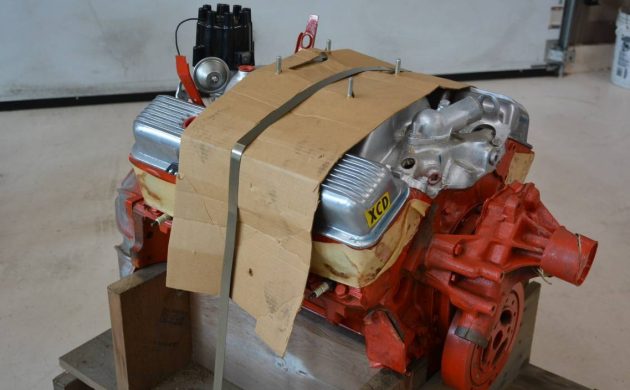

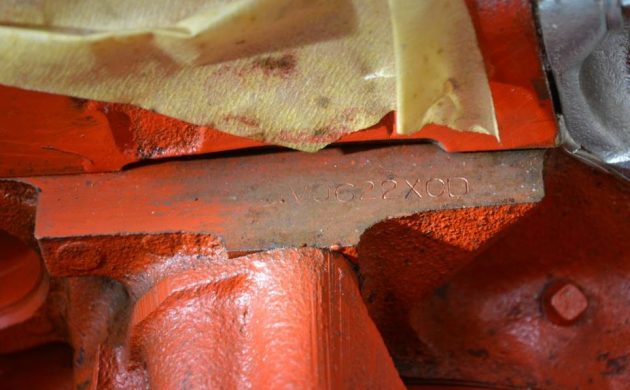
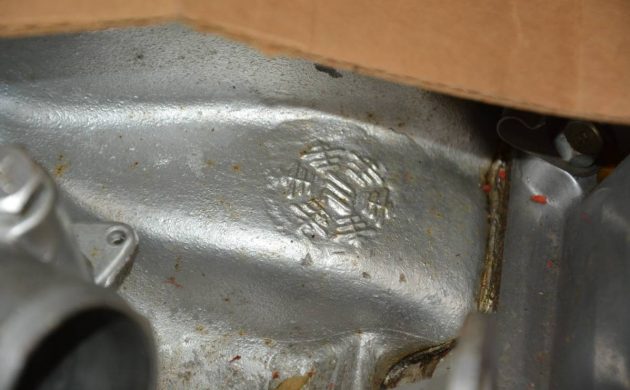
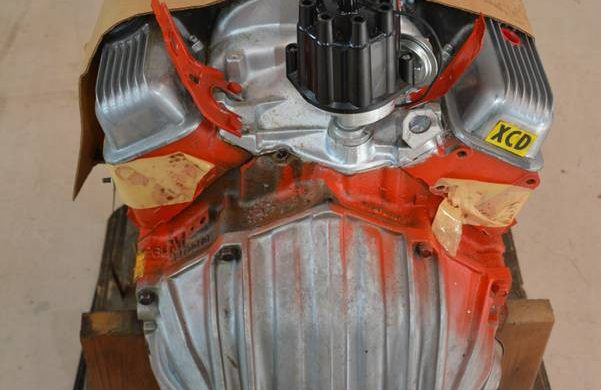
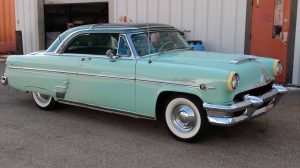

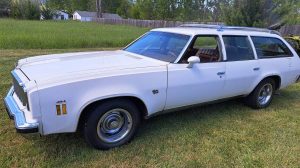



If someone wanted to protect/preserve the original motor of the ’70 Yenko Deuce listed here on BF a couple of weeks ago, they could slip this one in the car and have a whole lot of fun with perhaps less worries?
Having an engine, without the car to surround it, is an interesting spot to be in.
Saw a ’72 Nova at a gas station in Marshall, MI this afternoon, match made in heaven?
Great find! The 350/four barrel carb we had in our ’72 Blazer was one of the finest engines ever built. Lots of power, dead reliable, but hard on the gas budget at 11mpg whether it was going 80mph or parked in a parking lot. Our ’83 motorhome had the same engine and really hauled, even with our 22 foot box trailer behind it. Pretty hefty looking when compared to one of our 4 cylinder race engines.
Fascinating. I don’t know if you would need new gaskets. I wonder if there’s anything rusted internally? It would depend on how it was stored I guess.
Maybe someone could answer this for me, would you have to completely disassemble/reassemble this engine, or could you put it in a car, throw on a carb and exhaust manifolds and exhaust, oil it up and start it? I would think the answer would be the former…
expect to at least pull the heads for valve touch up … long storage of built engines is usually not kind to valve & seat surfaces ..
…while the heads are off, pour quality oil onto the cam & lifters … oil the cylinder walls a bit, and put a tube in the oil port to keep from having a mess, then rotate the crank to pump oil throughout the engine
put the heads back on, and run it in…do NOT let it run much idle
I would suggest “oil with plenty of zinc in it, or a zinc additive”. As you know this is very important to (non-roller) cams, especially in a performance motor where lift is more aggressive, and springs are stiffer. “Quality oil” is pretty open ended, and some people would think you mean synthetic or just a high grade.
Think “Brad Penn” Oil, a good place to start.
Tough call. Not sure there’d need to be a valve touch up. They’ve never been used. And the engine is, in theory, a sealed unit with oil inside it which, once again, has never been used.
My big concerns would be whether any moisture got into the motor, in which case you could score your cylinder walls on start up or even cranking it and the rubber seals are dry rotted and would leak, though I think these used cork gaskets on the valve covers and oil pan.
You could probably get a sense of their condition by just looking at them. If they appear dried out, I’d pull the valve covers and oil plan and replace those.
The former concern could be addressed by putting a camera scope down the spark plug holes and intake passages. If I saw no signs of rust, I’d probably give it fresh oil, install it in the car, and rock out.
No, buy a new crate engine from Chevy. This is a novelty that comes fraught with headaches. I have always argued that trying to add value to something for profit is a fools game, somewhere down the road someone is going to lose when common sense gets off the toilet and steps back into the room. Just use a car for its intended purpose. If you want to make money, learn how to type or something. (okay, maybe that dates me, but you get the idea)
@Leland
says “trying to add value to something for profit is a fools game”
That’s kind of insulting to all of of who have spent our lives adding value to something for profit….we are not fools.
Let me be more clear. Of course restoration is a good thing, with in reason. What I mean is , saying that this old engine is inherently worth much much more then a brand new one at a third the cost. That is what I mean by adding (artificial) value. If you are some rich guy that gets off telling the world that yours is sooo much better and valuable because it is numbers matching or something, fine, but that raises the prices for the rest of us who just want to drive and enjoy our cars. Profit is a good thing, it has made our world what it is today, but when it goes too far, it gums up the machine, leaving a sticky residue that is hard to come off.
Leland, you aren’t going to get a quality pan to manifold brand new crate engine or decent performance rebuild for anywhere close to $3,200. Even then, when someone chooses an entry level engine you will get an engine assembled with the cheapest offshore parts available.
The asking price is stiff, but that’s likely a starting point. Potential buyers are looking for a period correct engine for a specific style of build. It’s not intended for the average enthusiast.
Steve R
@SteveR, I see what you are saying, but doesn’t all the attention on these “investment cars”, just bump up the prices for all the rest of us? As far as a crate engine goes, I guess my elderly eyes misread the price, still, a crate engine would be closer to half, plus it is guaranteed to run with a warranty, no end of a tear down and rebuild.
Leland, I don’t buy into that high prices for certain “investment cars” bumps up prices and keeps people out of cool cars. When I was just out of high school in the early-80’s I wanted LS6 Chevelle’s, 69 Z28’s, Shelby’s and Hemi cars, but was priced out of those. Later on I realized i hadn’t learned how to properly search for cars and was relying on various forms of classified ads. I learned very quickly to appreciate more affordable cars such as 383 Road Runners, small block SS Camaro’s and others. As they became more expensive, to the point where they cost more than I was willing to pay I moved on to generic cars from the same platforms or later model performance cars.
There has never been a shortage of interesting cars at affordable prices. Anybody that is open minded can find something without much effort, they key is being flexible. I have a few friends that never learned that lesson, they weren’t willing to settle. They also weren’t willing to put in the effort to find their dream cars when they were relatively inexpensive and plentiful. It does no good for people to gripe. To me, the idea that people are priced out of the market is a false narrative, it always has been and always will be.
Steve R
@SteveR, What you say is true, but the more people buy up the baseline cars to clone high performance ones, the more expensive they get. I guess what I want is never going to happen before I die. Maybe I can get a nice coffin, though.
Leland, who said anything about clones. I’ve ever understood the desire to own or build a clone. I’ve always liked modified cars, that’s what I always did when I had a real muscle car. Maybe that why me and most of my friends couldn’t care less about auction prices, we don’t have the desire to parade around in a fake gussied up to look like it’s something it isn’t.
That leaves almost the entire spectrum of cars open to consideration when looking for a project. Like I’ve said before, there are reasonably priced desirable cars everywhere, all someone needs to do is look around with an open mind to find them.
Steve R
@steveR, You missed my whole point. I said base cars that you basically said, were inexpensive, have now become much more expensive because they are used as a cheaper version of something far more exotic. No, I do not want a clone, I want the base car(s) that I drove when I was young, but because many clone them, they to are out of reach. As I said, at least there is that perfect casket. Maybe I can put R/T stickers on the outside of it. Making America Great Again? Not for some things, that is for sure.
The 10 HP difference may be GM-speak for “The Corvette will always be the big dog in HP ratings whether it’s true or not”
The 10hp came primarily from the different exhaust manifolds and exhaust plumbing but the open element air cleaner vs the dual snorkel probably played a part too. The long blocks were the same.
randys:
I thought that at one time too but the SAE gross horsepower measurement, still used in 1970, does not consider the air cleaner/air induction system or exhaust system in measuring brake horsepower.
Unlike the current SAE net and/or certified measurements which are an “as installed” measurement, the gross measurement system used a simple air hose connected to the carburetor and four-tube headers attached to the exhaust ports of the engine while it was on the dyno. The net measure uses the stock exhaust system, air cleaner, standard timing (instead of max.timing), and the inclusion of the belt, alternator, and water pump – all things not employed in the gross measure.
We all know these things, air induction and exhaust, affect horsepower output and measurement, and the SAE net measurement takes that into account, but the gross measurement didn’t. It makes one wonder what the real purpose of the gross measure was and why it was used.
I think Frank is right and noted his position in the article, Corvette has to be top. It is either an arbitrary “difference” on paper or a matter of rating the Z28’s horsepower at a slightly lower RPM to achieve the difference. The SAE gross measurement, oddly, didn’t state “maximum horsepower”, it’s just logically assummed that it is the maximum rating. That’s one of the reasons, though not the only one, that the gross measure was discontinued after 1971. It was all too often “ginned” by the manufacturer for purpose.
JO
Was the painting really that poor on crate motors in 1970? Please tell me, I don’t know. I do know that the factory engine paint was pretty thin (on engines in the cars), but this really appears odd to me. Huge areas completely missed. Also look at paint difference between the heads near the intake? If anyone bought crate Chevy motors in that era, please comment. If your goal is an un-touched 1970 crate motor, then I say proceed with extreme caution.
Pretty much normal. These weren’t sold as “crate engines” so much in the day. These were sold as service assemblies mostly used for warranty purposes. They could be bought by the public but most Parts Managers wouldn’t order them because they were usually not eligible for return.
After sitting for 50 years the engine requires a full tear down and recondition. That’s 50 year old lubricant in the engine.
@A.G. I would only agree, if the engine had been run.
50 year old lube is better for flat tappet engines than most of todays oils, and if it had not been run and thus had no contaminents, there is no problem to be expected.
@JMB#7 I agree… Full Synthetic and ZDDP is what I call a quality oil for flat tappet AND current engines…
Dave many forums suggest running modern day diesel engine oil such as Rotella in these old engines based on newer technology plus they already have a good amount of ZDDP included. Any opinion or personal experience?
I stick with my LS1 stock 345 HP. Fast enough for me!
It would look wonderful sitting in the engine bay of my ’71 Camaro. Unfortunately that engine is worth more than the car is.
Lots of valuable information from all of you here.
My take away is this comment: “when common sense gets off the toilet and steps back into the room.”
Somehow that remark seems to explain an awful lot of things these days.
The “goo” on the crate engines is pretty sturdy stuff. What you need to do first as you check the engine is replace the valve springs. If the valves were adjusted at the factory then a portion of the springs would be under compression giving them different and weaker tension values. Either way, as has been said, you need to get into the engine before it runs.
Dave.. We run the Lucas synthetic race oil in our flat tappet engines. It’s got everything you need for keeping engines together for racing but they have a street car oil similar to the racing oil with the additives required for street engines. Quality of the oil is fabulous.
Chevrolet never painted intake manifolds the way this engine is painted however someone definitely did a sloppy rebuilder in a can camouflage job.
Be ready for a few surprises.
Have a most awesome weekend!
I know that engine paint jobs were never job one, but the intake manifold looks to have been brush painted. Could it have been shipped this way?
The article says it’s an aluminum intake manifold. And it’s untarnished, never gotten to operating temperatures and back to cold and on and on. That’s bare metal. It looks good, too.
craigslist picture #14 shows some silver paint on the head (brushed) and a very small spot of orange paint on the intake. I am not disputing if it is aluminum or not. But someone at some point in time did brush on some “silver or aluminum” paint. Why? I have no clue. Maybe this happens at the factory, I don’t know.
My bad, is that a separate water manifold from the intake? Still there is the two colors of paint mixed between it and the head.
Looking nat the ads pics, it’s hard to tell. In some spots, the intake gasket is silver in places, in others orange, others bare cork. Orange paint in spots on the manifold. Maybe the inlet for the upper radiator hose is bare aluminum and the manifold painted? Would be nice to look under the cardboard!
I would throw it in an old car put a carb on her, fire it up run it at 8k see it she blows……………………
Did bell housings, plugs, distributors, water necks, etc. normally come on replacement crate engines in the early 70’s? When I worked at a Chevy dealership in the late 70’s warranty claims weren’t very generous. Lots of questions on this one.
How will this 50 yr old motor run on today’s crap gas? Won’t you need racing gas or expensive octane booster? & lead substitute?
Steve R, would you say this $3200 400 hp 350 motor from Year One is built with cheap offshore parts? —>
https://www.yearone.com/Product/automobilia/ct350pc1
Maybe.
At least it will run on pump gas.
Listening to this,I’m starting to feel bad about the practice we have of squirting a little oil in the spark plug holes, spinning the engine a couple of times and then seeing if it would fire up without doing anything to it. Admittedly those engines had been run back in the day, but 50 years is 50 years. Oil degrades over time even if you don’t do anything to it. Take some out and squeeze it in your fingers next time you find an engine that sat that long. You can actually feel the difference.
Moisture gets in or was already there. No matter what, rust happens in the darndest places. Spinning the engine just puts a coat of oil on top of that rust spot.Not enough anti oxidants in oil to actually dissolve the rust. How could something not get scored under these conditions? Time waits for no man, or woman.
having had 3 of these xcd engines, back in the early 70s, and finding one like this, still in the crate, exactily as i got mine, i would take this one, appart and go completely through it to prevent any damage to it, and like one person said, replace the valve springs, for sure…. all the parts that were in mine, were high quality,, turftrided steel crank, pink rods, fordged 11-1 pistons, hi pressure oil pump, windage tray, high lift, 0 tip rockers and steel tip push rods, guide plates, etc. mine also had the bigger straight spark plug heads. the factory came out with angle plug heads, later, which didnt work with early headers, but were worth 15 hp..
Candia, just a few miles away from me.
If this is the original owner in the same location, I bet this engine was brokered through Dobles Chevrolet in Manchester. They always had a great Parts Department and I could get N.O.S. parts for my ’70 Corvette well into the late 80’s.
i didnt see my first post. i bought my first xcd crate motor in billings, montana in 1971, for $761.00. they had an LS-6 in the showroom for $824.00. they had more in inventory. bert chevrolet, in denver, also had these engines.. irrigators were buying them to run their wells, but found out they needed premium fuel, so went to lower compression, big cubic inch motors, like olds 455, etc..
I use Schaeffer oil in my 1970 Nova 350. This oil has zinc in it which is good for a 98,000 mile engine.